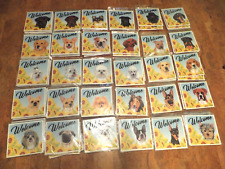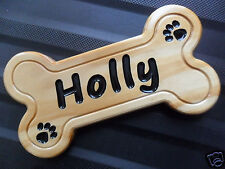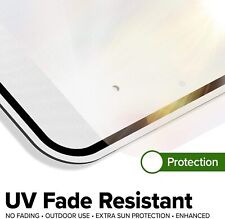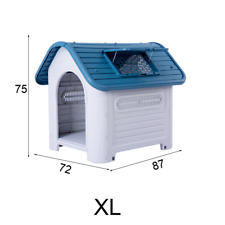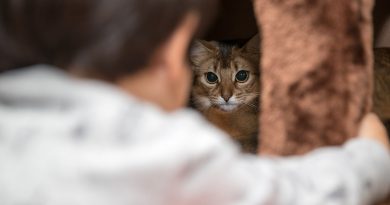How Old is Old? Signs of Feline Ageing

Within the past 5-10 years, veterinary medicine has seen some significant improvements in treatments for the ailments commonly faced by ageing cats. Like people, cats do not live forever. They age at different rates – some slow down at the age of 8, others remain spry into their teens or early twenties.
Most glide gracefully from middle age into old age, simply slowing down their pace of life. They experience old age in different ways and at their own pace. Grey hairs appear round the muzzle and in the fur (some owner therefore refer to older pets as "silvers").
An elderly cat grows thinner; its backbone, hips and shoulders become more prominent as it loses the insulating layer of fat under the skin. It may become rickety or unsteady on its back legs and its senses are less acute.
These are all signs of "winding down". Older cats exercise less and sleep more, they groom less thoroughly and less often. They lose their appetites. The early stages of this decline are so gradual that owners may not notice it. Recognizing subtle signs early on can slow the rate of decline, but at the end of the day, ageing and death are natural processes and unlike humans, cats do not seem to fear the end.
The average cat life-span is 12-14 or 14-16 years depending on which studies you read. Pet food manufacturers recommend senior formulation foods for cats over the age of 8 and many vets consider the cat geriatric when it reaches 10 years old. Generally, once your cat is over 12 years old, it is an ‘older cat’ and its needs and habits change.
Popular belief has it that one year of a cat’s life is equivalent to 7 human years. In fact, kittens mature faster than human children and the rate of ageing slows down to one year equaling only 4 human years after only 2 years as the equivalence chart below shows:
| Age of Cat | Human Equivalent | Comments |
| 2-3 months | 9-12 months | Kittens/humans weaned. Kittens are becoming less dependent on the mother. |
| 4 months | 2-3 years | Talking/adult communication in children. Under natural conditions, the kitten is fully independent of the mother. |
| 6-12 months | 12-15 years | Sexual maturity, most females now fertile and able to have young although they may not be fully-grown. |
| 2 years | 24 years | Could have raised children. |
| 3-6 years | 28-40 years | Human career-making |
| 6-9 years | 40-52 years | Middle age spread, menopause for some women. |
| 9-13 years | 52-65 years | Human menopause and retirement. Most cats are beginning to take things easier. |
| 13-17 years | 65-85 years | Active but ageing. Signs of senility in some individuals, senses less acute, injuries heal more slowly or incompletely. Internal organs less efficient. |
| 17-19 years | 83-92 years | Probably frail due to loss of bone density, subcutaneous fat and muscle tone. Skin more fragile. Hearing, sight and mobility affected. Less supple. |
| 19-22 years | 92-100 years | Amazing. |
| 22+ years | 100+ years | An exceptional individual |
| 30 years | 136 years | Several cats have recently attained this age. |
| 34-36 years | 152-160 years | Official longevity records noted in the Guinness Book of Records. |
| 43 years | 188 years | Unofficial (unverified) longevity claim; cat was apparently still active and was killed by a train. |
The figures are based on veterinary and behavioral research, though as with all individuals there is a wide degree of variation and there are always exceptions, with some cats and humans enjoying a robust old age. Some individuals mature earlier or later than average and some remain active while their age-mates are taking life easy.
Ageing is a natural process. The body processes wind down and some functions (reproductive ability) and faculties (hearing, cognition) diminish or are lost. The metabolic rate declines and everything slows down. This makes an older cat less tolerant of anesthesia and certain drugs and less able to regulate body temperature. It feels the cold more and suffers more in extreme heat. Its calorie needs decreases but the need for easily digested protein increases because its digestive processes are less efficient.
Older cats have less immunity to disease and their injuries heal slower. Hormone-producing organs no longer regulate themselves efficiently making older cats more prone to conditions related to malfunctioning glands. The senses gradually become less acute though cats adjust their lifestyles to compensate. Progressive deafness is the most commonly observed change. Sight becomes less acute. Senses of taste and smell may diminish and the cat may become faddy. Reflexes are less acute and the body is slower to repair injury damage.
What Are the Signs of Ageing?
Physical signs include: cloudy eyes, hearing loss; thinning fur; feels the cold; loose skin; prominent spine, shoulders and hips; loss of muscle tone; stiff joints or lameness and gray hairs around the muzzle and in coat. Behavioral signs include: less tolerance of environmental changes; sleeping more deeply and more often and generally being less active. Some older cats become more irritable or cantankerous due to deafness and/or joint pain, while others mellow with age. Most become more laid back and sociable with those they regard as friends. These are all age-related changes, but sudden mood changes may indicate illness or injury. A cat which starts hiding, becomes unsociable or which seeks constant reassurance may be unwell, so ask your vet to check that all is well.
Although old cats are usually laid back with visitors, they dislike major disturbances in their home environment. If you are holding a noisy party, put Puss a in warm, quiet "safe room" with his bed, food, water and litter tray. He can avoid the noise and disturbance and feel safe, secure and relaxed. There are notable exceptions and some cats – old or young – regard parties as prime lap-hunting, attention-seeking time, but even these require a safe place to retreat to when they tire of socializing
Many older cats remain active in their teens or twenties, though ageing cats tire more easily and start to take things easy. They should be encouraged to take moderate exercise to keep them healthy, but play sessions are shorter and more sedate with little of the athleticism of youth. Reduced exercise means you must trim his claws more often (see later).
Older cats are often very companionable; enjoying attention and relaxing in your company so it can be a rewarding time for you to indulge your nurturing instincts. Ageing cats adapt their lifestyle to cope with any incapacity; slowing down gradually, seeking warm, comfortable spots and spending more time asleep. They sleep more deeply and are harder to rouse, so don’t suddenly disturb a sleeping cat or it will be startled, especially if its hearing is fading. This deep slumber also shows that the cat feels safe.
As cats grow older, stiffer and lose muscle tone, high surfaces (windowsills, shelves, kitchen counters, your bed) become inaccessible unless you provide a ramp or box as a stepping stone. Tables and counters may become cat-free zones and ornaments be are less likely to be overturned. The cat’s curiosity is unabated, but he no longer exerts himself or his muscles are not up to the jump. Instead of active pursuits he may turn his attention to socializing quietly with you. He may prefer to sit near you rather than on your lap. This is not a snub; depleted fat stores means he is bonier and finds your lap uncomfortable. Put a cushion or folded blanket on your lap to make it more comfortable when he wants a cuddle. If he is allowed in the bedroom, spend an half-hour or more sitting up in bed reading with your legs tucked under the duvet or quilt – he will find that the duvet makes a supportive "hammock" between your legs.
Middle-age spread (through overfeeding and under-exercising) eventually gives way to boniness as subcutaneous (under-skin) fat stores become depleted. The spine, shoulder blades and hips are more prominent; his muzzle appears "sharper" and the eyes more prominent as fat around the face is lost. You may notice changes in how he moves as he becomes stiff and "rheumaticky". He may stand with forelegs wider apart as degenerative changes occur in the joints, giving him a saggy, barrel-chested appearance. This may also help increase his chest capacity and breathing as the heart and lungs work less efficiently. This is nicknamed "clockwork kitty" syndrome as his movements give the impression of a wind-up toy.
What is Ageing?
He may develop a tendency to walk on his hocks due to muscle wastage in the hind-legs. This also restricts running and jumping. Hock-walking is also associated with the after effects of saddle thrombus (see later). He becomes generally less supple and finds it harder to curl up into a tight ball so a larger cat bed may be necessary. Beanbags mould themselves to his shape and provide support while the polystyrene beads in a beanbag will retain heat and help keep him warm.
Fleece-covered cat hammocks are comfortable, but make sure he can get in and out of it easily. Older cats often become talkative, spending less time physically active and more time expressing their opinions. Some are seeking reassurance, but others take a chatty interest in your activities. Not only do they enjoy your company, they tell you how much they enjoy it! Some of the increased vocalization (especially increased volume) is due to deafness – the cat literally can’t hear himself speak.
Extremely old cats may become forgetful, suffering "senior moments", staying outdoors in bad weather or wandering and becoming lost. These are signs of senility though the cat may enjoy several more months of reasonable health if senile behavior can be managed. Cats which wander and become lost should be confined indoors for their own safety. If you have an escape-proof garden they can venture out in good weather or they may go out on a harness and lead. A senile cat which house-soils should have a veterinary check-ups to determine whether this us a physical problem or senility. Providing several litter trays around the house may help for a while, but when age-related problems become too acute you must review the cat’s quality of life and consider euthanasia.
If it is any reassurance, a cat which lives long enough to become senile has survived far beyond the life-span of a wild-living cat. Few feral cats or wild animals reach senility; as a wild animal loses its faculties it becomes prey for something else, dies through self-neglect or through misadventure. A cat which lives long enough to become senile has probably had a comfortable, nurtured life and this fact may comfort you if you choose euthanasia because of senility and related problems.
Do Old Cats Become Disabled?
Although the senses decline, old age doesn’t always mean disability. In cats, the disability usually occurs gradually enough for it to compensate. Even sudden disabilities (amputation, stroke) are less drastic than you might think because an older cat is generally less active and notices his limitations less than an active, younger cat. As a cat ages, sight and hearing deteriorate, often so gradually that you don’t notice anything until the loss is total.
Your cat compensates by relying more on remaining senses, especially smell, to guide him through his daily routine. Because older cats have a more relaxed approach to life, most appear unperturbed by failing hearing or sight. The problems of deafness and failing sight can be counteracted by a caring owner. Failing sense of smell is more problematical as it causes loss of appetite. Though there is no need to become over-protective, it is worthwhile being aware of some disabilities which may afflict cats.
Amputation
The loss of a leg through injury may sound catastrophic but 3 legged cats adapt well. A recent amputee needs time to adjust, but once recovered is as agile and active as any 4 legged cat and soon resumes previous activities with little sign of being handicapped. He needs help grooming areas that were groomed by the now-missing leg, but will otherwise be as active and independent as before. The fact that an older cat is generally less active means he is less troubled by the limitation of 3 legs.
Deafness
A deaf cat is easily startled because he can’t hear you approaching. He sleeps more deeply because the lack of sound gives him a false sense of security. Deaf cats can learn to recognize hand signals or the flashing of a torch (flashlight) to call him in for meals or at night. At close range, sharp hand-claps may still gain a partially-deaf cat’s attention. Deaf cats cannot hear danger signals such as cars, lawnmowers or barking dogs. If he goes outdoors (or could escape outdoors), make sure he wears an elasticated (or break-free) collar bearing his address and write ‘I AM DEAF’ on the collar to help people who find him on their driveway or in their garden. A noisy collar bell helps you to locate him when he is in motion. It is safest to confine a deaf cat to a safely fenced garden or indoors.
Blindness
A cat which bumps into things may be losing its sight. A cat blind in one eye is easily startled by sudden movements on his blind side. Blind cats are easily disoriented and must not be allowed to roam; indoors only or indoors with access to an outdoor enclosure is best. He may enjoy walking in the garden using a harness and lead and these trips can be enjoyable for you both as you can observe what things attract the attention of your cat. Make sure he wears an elasticated collar stating his address and disability in case he escapes and becomes lost.
Blind cats rely on scent and memory to find their way around so keep furniture, food and litter in the same place and don’t leave obstacles in unexpected places where he could walk into them. Carrying a blind cat around will disorient him so if you do move him, place him at floor level somewhere familiar e.g. his feeding or sleeping area so he can easily get its bearings. Sound is very important to a blind cat and many enjoy playing with jingle toys or rustling paper (e.g. paper grocery bags).
Deaf-Blind Cats
It is rarer for a cat to lose both hearing and sight. Such cats are far safer indoors as they can easily become lost or hurt outdoors. Many adapt well and still enjoy life, relying on their sense of smell. The fact that older cats are less active anyway means that they are less distressed by these problems than you might think. If you feel that your cat is distressed by its condition, you should discuss the matter with your vet who may recommend euthanasia, especially if the cat has other age-related problems as well.
Strokes
True strokes are uncommon in cats and those that do have them usually recover faster and more completely than humans though they may remain slightly lopsided. Following a stroke, the cat may be temporarily blind or partly paralyzed and may lose control of bladder or bowel. Most vets advise a "wait and see" approach. Once the initial effects have worn off, many cats go on to live very long, healthy and happy lives with little more than a head tilt, minor tremor or slightly wobbly gait as a reminder.
Saddle Thrombus (described in more detail later) is sometimes called the feline equivalent of a stroke and can cause permanent weakness of the hind legs. Affected cats may need ramps or steps to compensate. He may temporarily lose control of bowel or bladder depending on the severity of the damage. One of my elderly cats recovered well, but afterwards she always leaned on the wall when going up or down stairs.
How Can I Prolong My Cat’s Life?
Ageing is affected by both genetics and environment. Good genes are down to luck or careful breeding, but the environment can be managed. There is a danger of becoming paranoid – whatever you do, you must accept that your cat is not immortal. Keep a diary or file detailing your cat’s vaccinations, diet and weight. If you can, record its heart-rate, breathing rate and temperature – your vet will show you how and tell you what the normal figures are.
If your cat becomes sick, injured or behaves unusually make a note of this since cats often behave totally different in a vet’s consulting room! Your observations will help the vet work out what, if anything, is wrong with your cat. Some cats do developed unexplained and harmless behavioral quirks, don’t panic – this is called "being a cat".
Some diseases are hereditary and reduce life-expectancy. Genetics is a key factor in determining the rate of ageing, how well cells multiply and how well the body repairs itself. Providing good health care for your cat right from kitten hood assures its genetically determined life span. If you don’t know much about your cats past history, the "good health care" routine starts with you!
Cats are resilient creatures and many rescue cats reach advanced ages, especially mixed-breeds as these have "hybrid vigor". Breed influences longevity and Oriental/Siamese breeds appear to live longer than Persians. Years of selective breeding has had the side-effect that some breeds are genetically predisposed to conditions which shorten life – the reverse of hybrid vigor.
With improved owner education, neutering, vaccinations and modern vet care, cats are living longer than ever before and spending proportionally more time in their senior years than their ancestors. A modern cat averages 12-16 years compared to 6-8 years in the 1930s i.e. life expectancy has doubled. Whether an indoor or indoor/outdoor lifestyle influences this is down to the locality and whether the outdoor access is free-ranging or via an enclosure. In some areas indoor/outdoor cats average 8 years, elsewhere they average 12-14 years. In the UK, my indoor/outdoor cats average 16 years, with several reaching 19-21 years (the exceptions died of kidney disease and of cardiomyopathy, neither condition being linked to their lifestyles).
Where outdoors is too dangerous, an indoor lifestyle prolongs life. Where outdoor dangers are moderate or minimal, it is up to you to judge whether your cat should enjoy outdoor pleasures. Remember – your cat lives for now, help him enjoy every minute of ‘now’. Some people consider the risk of infectious disease means indoors-only, others accept that the risk to a neutered cat is relatively small and that fatal accidents also occur in the home. Weigh up the risks and make an educated decision. What is right for your locality may be wrong for someone else’s locality.
Neutering and vaccination are important. Neutering extends a cat’s life-span and reduces the risk of contracting several deadly viruses. Vaccination protects against some of the diseases prevalent in your area. Good diet, good observation of your cat’s habits and regular health checks are vital. Older cats are less active and have a reduced metabolic rate, so you must adjust their food to their decreasing activity level to prevent obesity. Noticeable or sudden weight loss signals serious problems so be aware of your cats normal weight and note any changes. Only prolong relatively healthy or active life, never prolong the life of a suffering cat. The subject of euthanasia is discussed later.

